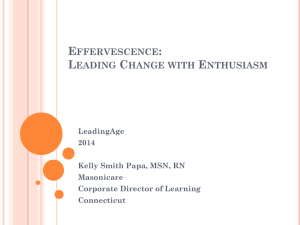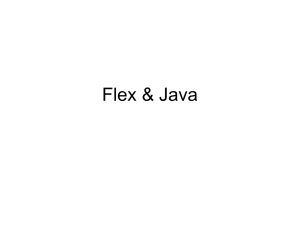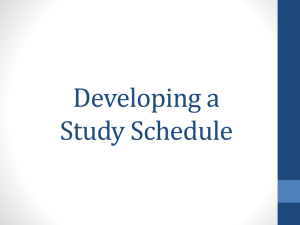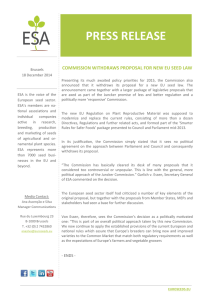the FLEX mission and instrument concepts - NCEO
advertisement
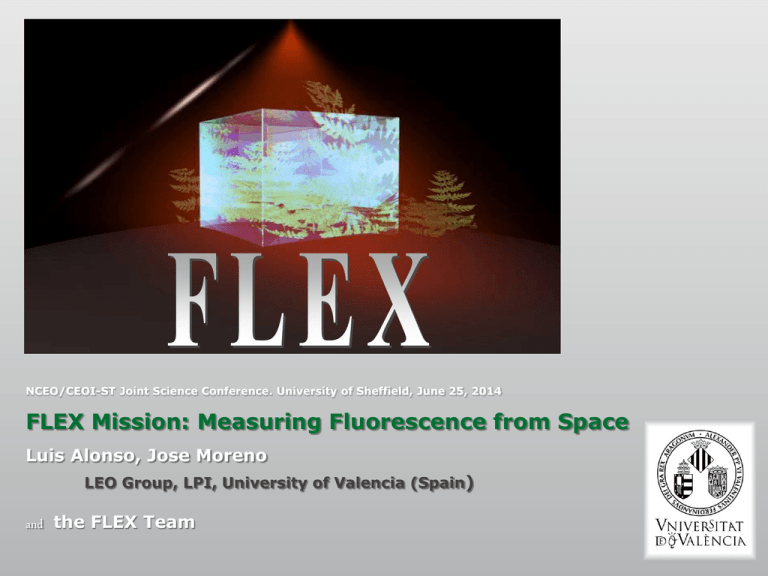
→ NCEO/CEOI-ST Joint Science Conference. University of Sheffield, June 25, 2014 FLEX Mission: Measuring Fluorescence from Space Luis Alonso, Jose Moreno LEO Group, LPI, University of Valencia (Spain) and the FLEX Team ESA’s living planet programme Explorer 8 mission candidates under study since 2012 • CarbonSat Monitoring CO2 content of the atmosphere (sources, sinks, hot spots) • FLEX FLuorescence EXplorer Monitoring vegetation fluorescence – the breath of the Earth Slide 2 NCEO/CEOI-ST Joint Science Conference 2014, Seffield ESA’s FLEX Earth Explorer FLEX – mission objectives • Primary scientific objectives Accurate global mapping of vegetation fluorescence (emission spectrum) Estimate the actual global photosynthetic activity via related light absorption and emission Vegetation health status / stress identification Enhance knowledge on anthropogenic impacts associated to land use changes • Secondary scientific objectives • Understanding of the terrestrial component of • Improvement of GPP modelling Slide 3 the CO2 cycle NCEO/CEOI-ST Joint Science Conference 2014, Seffield ESA’s FLEX Earth Explorer -1 -2 Radiance (W m sr What is fluorescence? 0.20 0.15 WR with filter 0.10 0.05 B 0.12 -1 Radiance (W m sr nm ) leaf without filter 0.10 -1 -2 Incident solar light can be either reflected, absorbed or transmitted by a leaf. 0.00 0.14 0.08 0.06 0.04 leaf with filter Fs 0.02 0.00 400 500 600 700 Wavelength (nm) The absorbed light photons can be used for photosynthesis or can be dissipated. Dissipation can occur as Non-Photochemical Quenching (e.g. heat) or emitted as fluorescence (SIF) photons. Slide 4 NCEO/CEOI-ST Joint Science Conference 2014, Seffield ESA’s FLEX Earth Explorer 800 900 Dynamical fluorescence emission Fluorescence emission spectra from two different species exposed at two levels of air pollution 0.000020 Platanus • Total Fluo Yield [1/nm/sr] Low Pollu on High Pollu on 0.000015 0.000010 650 0.000020 700 750 Wavelength (nm) 800 850 Phoenix Canariensis Total Fluo Yield [1/nm/sr] Low Pollu on High Pollu on 0.000015 Environment – Plant structure – Stress Two peaks of the fluorescence emission are highly variable • Difference in shape between pollution levels, but also between species Ref: Van Wittenberghe et al. Upward and downward solar-induced chlorophyll fluorescence yield indices of four tree species as indicators of traffic pollution in Valencia 0.000010 0.000005 0.000000 650 Slide 5 – • 0.000005 0.000000 Fluorescence is influenced by 700 750 Wavelength (nm) 800 NCEO/CEOI-ST Joint Science Conference 2014, Seffield 850 ESA’s FLEX Earth Explorer Environ Pollut, Vol 173, 2013 http://dx.doi.org/10.1016/j.envpol.201 characteristics have been created to test the atmospheric correction algorithm. Measuring a faint signal FSIF + W. Verhoef, H. Back. Simulation of hyperspectral and directional radiance Images using coupled biophysical and atmospheric radiative transfer models. • TOA LTOA – Light seen at the top of the atmosphere (instrument input radiance) LTOA • • P é (Edir × cos(J ill ) + Ediff )× rSurf ù + FSIF ú × t atmosphere ê p û = L0 + ë 1- Salbedo × rSurf L0 – S S P BOA Atmospheric path radiance S Edir/diff – P Diffuse and directly flux reflected by Earth and transmitted through the atmosphere • ρSurf • τatmosphere • Salbedo – – – Slide 6 O2-A Water Vapor Signal is modulated by the Earth surface reflectance O2-B Sensitivity to atmospheric changes Atmospheric pherical albedo NCEO/CEOI-ST Joint Science Conference 2014, Seffield ESA’s FLEX Earth Explorer Spectral resolution Finer resolution: lower SNR Coarser resolution: loss of spectral features Slide 7 NCEO/CEOI-ST Joint Science Conference 2014, Seffield ESA’s FLEX Earth Explorer FLORIS band configuration FLORIS-HR FLORIS-LR Band PRI Chlorophyll absorption [nm] 500-600 600-677 O2-B Red-edge 677-686 686-697 697-740 SR (FWHM) 3.0 0.7 0.3 2.0 SSI 2.0 0.5 0.1 1.0 SNR 300 400 300 600 Slide 8 NCEO/CEOI-ST Joint Science Conference 2014, Seffield O2-A 740-755 755-759 759762 0.7 0.5 Linear from 1200 600 to 1200 ESA’s FLEX Earth Explorer 762-769 0.3 200 0.1 Linear from 200 to 1200 769-780 0.7 +REP 0.5 +Cab 1200 FLEX / S3 tandem concept o FLEX will fly in tandem with Copernicus’ satellite Sentinel3. Synergy between the different instruments for: FLEX Atmospheric characterization and correction Vegetation biophysical parameters Surface temperature o o o Sentinel-3 OLCI TOA Rad FLEX SLSTR TOA Rad FLORIS TOA Rad Dual View Coregistration Crosscalibration Spectral Calibration FLORIS TOC Etot Atmospheric State Atmospheric Correction Cloud Mask Slide 9 FLORIS TOC Refl OLCI / SLSTR TOC Refl Fluorescence Retrieval Biophysical Retrieval NCEO/CEOI-ST Joint Science Conference 2014, Seffield L2 Fluo Map L2 Photosynthesis L2 BIOPHYS Params Altitude: ~815 km Local solar time: 10:00 LTDN ESA’s FLEX Earth Explorer Temporal co-registration: < 6s (G) / 15s (T) Two-Step full-spectrum fluorescence retrieval Slide 10 NCEO/CEOI-ST Joint Science Conference 2014, Seffield ESA’s FLEX Earth Explorer Two-Step full-spectrum fluorescence retrieval Full Spectrum Retrieval Initial SIF estimates at O2 absorptions Requires (from Atmospheric Correction): • TOC Total Irradiance Etot and Êtot (modelled with no O2) • TOC Apparent Reflectance ρapp (includes SIF) Fluorescence True Reflectance n-parameters to be fitted initialization is required Irradiance [mW/m2/nm/sr] 1200 Estimated ρapp Interpolated no-O2 ρapp True ρ 1000 800 600 400 200 0 680 Estimated Etot Modelled no-O2 Etot 700 720 740 Wavelength [nm] SIF687 & SIF760 ρ687 , ρ760 𝜆 760 780 𝐹𝑠 = 𝜌𝑎𝑝𝑝 − 𝜌𝑎𝑝𝑝 ∙ 𝐸𝑡𝑜𝑡 ∙ 𝐸𝑡𝑜𝑡 𝜋 𝐸𝑡𝑜𝑡 − 𝐸𝑡𝑜𝑡 ) No assumptions about true reflectance ρ (large source of error in other retrieval method) Slide 11 𝐿𝑇𝑂𝐶 𝜆 − 𝐹 𝜆 − 𝜌 𝜆 𝐸𝑡𝑜𝑡 𝜆 ) 2 𝑚𝑖𝑛 NCEO/CEOI-ST Joint Science Conference 2014, Seffield ρ errors <1% and SIF errors <10% ESA’s FLEX Earth Explorer End-to-End Mission Simulator Scene location FLORIS OLCI SLSTR (nadir) SLSTR (oblique) Latitude [deg] 45.17 45.16 FLORIS Instrument Module 45.15 45.14 SEN3 Instrument Module 45.13 45.12 -0.46 -0.44 -0.42 -0.4 Longitude [deg] Scene Generator SEN3 Geometry Module Class map Slide 12 FLORIS Geometry Module Biophysical NCEO/CEOI-ST Joint Science Conference 2014, Seffield Level-1 Processing Performance Module Level-2 Retrieval Atmosphere ESA’s FLEX Earth Explorer Spacecraft and payload accommodation • S/C – ‘Small satellite’ – recurrent S/C bus – Wet mass <1000 kg – Power consumption <500 W • P/L – Power consumption ~120W – Weight ~120 kg – Data rate ~150 Mbps • Launcher • Coverage – Vega – Global (land + major islands, -56 to 75 degree latitude, coastal zones 50 km – Revisit time up to 19 days Slide 13 NCEO/CEOI-ST Joint Science Conference 2014, Seffield ESA’s FLEX Earth Explorer Instrument configurations • Phase B1 running – Instrument concepts frozen – Spectrometer refractive or catadioptric – Reflective or transmissive grating – One or two telescopes or spectrometers FLORIS Concept 1 Slide 14 NCEO/CEOI-ST Joint Science Conference 2014, Seffield FLORIS Concept 2 ESA’s FLEX Earth Explorer FLORIS breadboards: Objectives • Demonstration of the manufacturability of the flight FLORIS Concept 1 representative optical elements (lenses, mirrors, coatings, filters, gratings, slits) according to the specifications • Demonstration of the assembly accuracy of the optical elements according to the accuracies as defined in the tolerance analysis • Verification of the alignment concept, contamination budget, general FLORIS Concept 2 accuracies and adequacy of the measurement signals • Demonstration/measurement of the imaging & spectral performance at focal plane • Tolerance of the instrument to thermal cycling Slide 15 NCEO/CEOI-ST Joint Science Conference 2014, Seffield ESA’s FLEX Earth Explorer Summary • FLEX will provide global mapping of terrestrial vegetation • Retrieval and measurement configuration will make use of • End-to-End Simulator with detailed implementation of every fluorescence at moderate spatial resolution full information content provided by FLORIS and Sentinel-3 aspect of the mission, allowing to test performance of each module • Accuracy of fluorescence measurement expected to be 10% • • FLORIS breadboards in construction and under testing Slide 16 (as demonstrated by campaigns and by simulations) Phases A/B1 of FLEX to be completed ~03/2015 NCEO/CEOI-ST Joint Science Conference 2014, Seffield ESA’s FLEX Earth Explorer Thanks to the FLEX Mission Advisory Group • • • • • • • • • Slide 17 Yves Goulas Andreas Huth Gina Mohammed Franco Miglietta Jose Moreno Ladislav Nedbal Wouter Verhoef Uwe Rascher Betsy Middleton (observer) NCEO/CEOI-ST Joint Science Conference 2014, Seffield ESA’s FLEX Earth Explorer Questions? Would you like to know more? www.esa.int FLEX/PARCS http://ipl.uv.es/flex-parcs/ Slide 18 NCEO/CEOI-ST Joint Science Conference 2014, Seffield FLEX/PHOTOSYN http://www.flex-photosyn.ca/ ESA’s FLEX Earth Explorer System / instrument requirements Requirement Instrument type Specification Pushbroom Imaging Spectrometer Mission lifetime Data latency 3.5 years (T) / 5 years (G) 5 h (T) / 24 h (G) Coverage -56o < latitude < 75o Pitch angle Swath width Spatial Sampling Distance Integrated energy <5o 150 km 300 m >70% over an area of 1.1 SSD Spectral band coverage Spectral Resolution and Sampling 500 nm – 780 nm 0.3 nm / 0.1 nm (HR) 2 nm / 0.65 nm (LR) Signal to noise ratio Spectral stability > 200 at 761 nm 1nm Over mission lifetime 10 pm for FLORIS-HR During observational time of 1 orbit Straylight sensitivity 0.1 SSI nm for FLORIS-LR Specified for black & white scene To maintain radiometric requirement Spectral co-registration Spatial co-registration Knowledge of ISRF Absolute radiometric accuracy <0.1 SSD <0.1 SSD Better than 1% 2% (G) 3% (T) Smile Keystone Relative accuracy Polarisation sensitivity 1% 2% (FLORIS-LR) Spectral and spatial Temporal co-registration 1% (FLORIS-HR) 6s (G) / 15s (T) Inter-channel temporal co-registration <2s Geo-location accuracy 0.3 SSD (with ground control points Slide 19 NCEO/CEOI-ST Joint Science Conference 2014, Seffield Comment Sun Zenith Angle < 75o Observation Zenith Angle < 15o Land area including coastal zones (50km) Preferably Nadir pointing Enables global coverage @ Nadir Excluding uncertainty of Sun radiance To avoid significant cloud movements ESA’s FLEX Earth Explorer Disentangling fluorescence from TOA radiance • Sensitivity analysis performed to establish spectral ranges and spectral resolutions • Competing effects – – • Slide 21 NCEO/CEOI-ST Joint Science Conference 2014, Seffield Atmospheric state variables Aerosol Optical Thickness (AOT) Aerosol height and model Surface Pressure Water Vapor Vegetation reflectance Disentanglement requires – High resolution for Oxygen B and Oxygen A – Medium resolution red-edge – Medium resolution elsewhere ESA’s FLEX Earth Explorer Retrieval evolution • Promising method for fluorescence retrieval: – independent decoupling of reflectance/fluorescence effects and atmospheric/topographic effects – Apparent reflectance ro’ = ro + Fs / LWLR true reflectance derived by elimination of the Oxygen absorption (no free fitting parameter anymore) Incoming radiance LWLR from radiative transfer programs • Other retrieval methods, where reflectance is a free model parameter, are currently under investigation • • Reflectance expected to be a smooth function of wavelength Retrieval accuracy expected to be about 10% for both – relative accuracy at the two emission peaks – total integral of the fluorescence radiance across the whole spectral range (total energy emission) Slide 22 NCEO/CEOI-ST Joint Science Conference 2014, Seffield ESA’s FLEX Earth Explorer FLORIS / S-3 band configurations • FLORIS (300 m SSD) • S-3 OLCI (300 m SSD) – Fluorescence – PRI – Camera 4 – 250 km swath – O1 to O4 (400 to 490 nm) – Atmospheric correction Aerosols – Apparent reflectance Chlorophyll Reflectance – O9 to O16 (510 to 779 nm) – Context information Slide 23 NCEO/CEOI-ST Joint Science Conference 2014, Seffield Cross calibration ESA’s FLEX Earth Explorer • SLSTR (500m – 1 km SSD) – VIS S1 to S3 and F1/F2 – SWIR S4 to S6 – Aerosols Reflectance TIR S7 to S9 Temperature Clouds (water vapour) Breadboard 1: system test equipment Slide 24 NCEO/CEOI-ST Joint Science Conference 2014, Seffield ESA’s FLEX Earth Explorer Radiometric performance • High signal to noise (SNR) required • Due to relatively large aperture, the • Other contributors have been large aperture (~80 mm) system is photon noise limited minimised SNRSample • N ph ( ) bana bdig 2 2 ( N ph ( ) N dark N smear ) bana bdig ( N readout N quant ) bdig Grating efficiency is essential Slide 25 NCEO/CEOI-ST Joint Science Conference 2014, Seffield ESA’s FLEX Earth Explorer Instrument response function Spectral (approximation) • Spatial Due to scattering of the optics and optical elements, the IRF is more sophisticated • Finite response at larger angles Slide 26 NCEO/CEOI-ST Joint Science Conference 2014, Seffield ESA’s FLEX Earth Explorer Straylight behavior – test case • Test of straylight sensitivity on black & white scene (Lref & LTOC) Slit Slide 27 NCEO/CEOI-ST Joint Science Conference 2014, Seffield ESA’s FLEX Earth Explorer Radiometric error due to straylight • • Slide 28 Radiometric error ~4% at absorption line Without correction NCEO/CEOI-ST Joint Science Conference 2014, Seffield ESA’s FLEX Earth Explorer Breadboard 1: telescope test equipment Telescope illumination system Lens barrel alignment tool First lens under inspection Knife edge scanner Slide 29 NCEO/CEOI-ST Joint Science Conference 2014, Seffield Field scan mechanism ESA’s FLEX Earth Explorer Breadboard 1: manufacture completed • • BB fully assembled Telescope and spectrometer line shapes measured • Very good performance achieved so far Slide 30 NCEO/CEOI-ST Joint Science Conference 2014, Seffield ESA’s FLEX Earth Explorer Breadboard 2: system test equipment BB optics fully representative BB and test equipment OGSE under definition Detailed design review approaching First grating samples tested Slide 31 NCEO/CEOI-ST Joint Science Conference 2014, Seffield ESA’s FLEX Earth Explorer Detector breadboard - CCD • Same detector for Concepts 1 • Split frame transfer CCD, • Line transfer times of and 2 1020 x 440 pixels (TBC) ~1.25 s, frame time of 45.8 ms • Pixel size 28 m x 42 m, full • Operating temperature 263 K, • Read noise <20e-, 2.5 MHz • ITT issued, under evaluation, well capacity ~2 Medark current of ~0.1 nA/cm2 readout rate start expected in June Slide 32 NCEO/CEOI-ST Joint Science Conference 2014, Seffield ESA’s FLEX Earth Explorer

